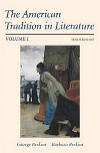 |  The American Tradition in Literature, Volume 1, 10/e George Perkins,
Eastern Michigan University
Barbara Perkins,
University of Toledo-Toledo
Texts OnlineYou can read the following poems (and in some cases hear audio versions) by clicking on their titles, or by consulting your textbook. The e-notations provided below offer links to sites that offer background or otherwise illuminate the works. Enjoy! "Reapers"
See page 1119 in The American Tradition in Literature, Volume II, 10/e This poem makes prominent use of both rhyme and alliteration ("sound of steel on stones"). To learn more about these and other elements of poetry, click here. In the poem, Toomer describes the workers he sees in a farm field. Farms and farm workers form a popular subject for the visual as well as the poetic arts. Look at this 16th-century painting, The Harvesters, by Pieter Brueghel, and think about how it compares to Toomer's poem. This poem was first published in Toomers book Cane, a work inspired by Toomer's time in Georgia. To learn more about the history of the state, click here.
"Song of the Son" If you read this poem on the Academy of American Poets homepage, be sure to click on the speaker icon and listen to a reading of the text. How did hearing the poem change your experience of the text? Did you like the poem better once you had heard it read? Obviously, this poem deals strongly with slavery in the United States. To learn more about the institution of slavery in North America, go to this site. Consider how the poem draws its power from the repetition of certain phrases. How does this poetic technique mirror the subject of the poem? What impact does it have to read the same or a very similar line repeatedly? Despite the simplicity of Toomer's language, this poem seems to have a number of meanings, many of them enigmatic and subtle. To read some critiques and possible interpretations of this poem, visit this page.
|
|



 2003 McGraw-Hill Higher Education
2003 McGraw-Hill Higher Education